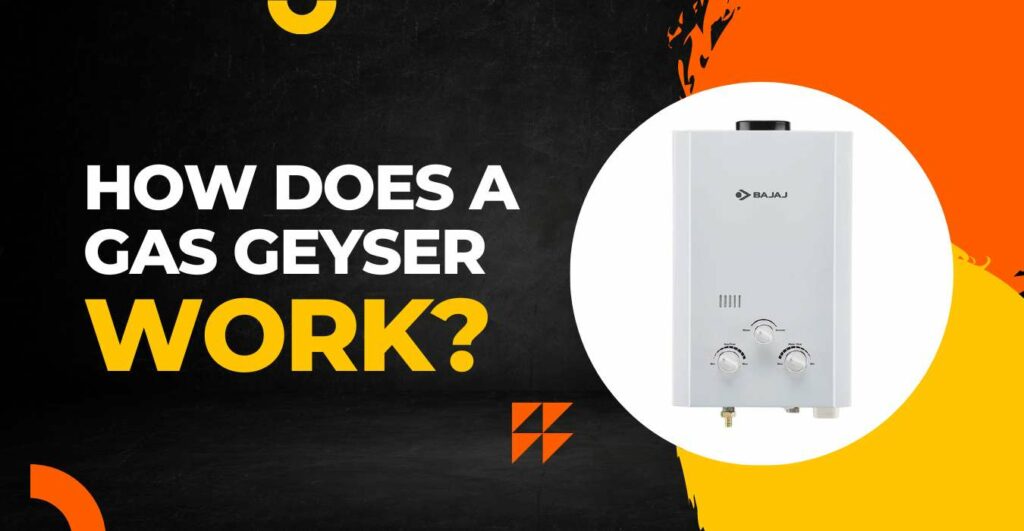How Does a Gas Geyser Work? Well, the process is not all that boring to start with. To start with, the appliance utilizes Liquified Petroleum Gas or LPG or Piped Natural Gas-PNG to heat the water. So, what does a Gas geyser look like? Let us get into the details:
The appliance comprises three different pipes: the Inlet pipe for cold water, the outlet pipe for Hot water, and another for gas. Once the tap has been turned ON, the cold water flows into the tank via the cold-water pipe. This further activates the inlet flow sensor. Once the water reaches the magnetic switch, a notification is sent to the Solenoid valve. This turns ON the gas pipeline.
Now, the gas flows into the burner and triggers the igniter. This causes the igniter to spark, and the flames are lit. Once the cold water flows into the heat exchanger, the heating process occurs. This is the hot water that flows through the hot water tap. Also, a temperature sensor is present in the heat exchanger. The function of the sensor is to keep a check on the temperature of the water, hence preventing the water from being overheated.
Working of Gas Geyser

Once the gas geyser starts the operation, the oxygen from the atmosphere is used to burn the gas. Hence, it is recommended to ensure the gas geyser has been installed in a properly ventilated space. There are cases when the gas geyser is installed in a poorly ventilated space, and the available oxygen is utilized, which can further increase the chances of a fire hazard. This is why some of the latest models of gas geysers also feature Oxygen Depleting Sensor-ODS. Once the Oxygen level has depleted, the gas flame grows more volatile and inconsistent. However, the ODS further senses this, and the feature helps avoid accidents by switching off the geyser.
The Advantages of the Gas Geyser
Let us take a look at some of the major benefits of gas geysers:
On a Budget: There is no denying that gas geysers help save a chunk of electricity bills. This is because gas is cheaper, as LPG and PNG are cheap gases to spend on. Also, the operational charges are quite less in this case.
Quick Heating: One of the best benefits of gas geysers is that they provide quick water heating solutions.
Better Control: With the help of the gas geyser, one is offered better control over the gas flow input. Also, one has better control over the process of heating. One can also adjust the water temperature according to the weather.
Easy Maintenance: With some of the simplest components and working principles, the gas geysers are simple and easy to repair and maintain. Also, the mechanism is simple to comprehend; hence one can be sure that the gas geysers offer ease of use and maintenance.
Parts of a Gas Geyser
Most times, gas geysers are a safe option. These are the best choice when concerned about electric short circuits and other such problems. Here are the details of the main parts of the gas geysers:
1. The Oxygen Depleting Sensors
There are cases when the geyser is operated in non-ventilated spaces; hence the burning of the gases will utilize the available oxygen. Once this happens, the gas flames grow inconsistent and volatile. As and when this happens, the ODS and the smart feature work by switching OFF the geyser for the sake of safety. Hence the fire hazards are prevented.
2. The Smart Flow Sensor
The smart flow sensor allows ignition only when a flow of water occurs for complete safety.
3. The Double Solenoid Valve
The double solenoid valve in the gas geysers ensures the prevention of accidents and safe usage. If one of the Solenoid valves fails, the second Solenoid valve gets activated in order to allow the complete functioning of the geyser.
4. The Child Lock
Some of the Geysers also come with the Child Lock. This ensures that the geyser does not operate even when the tap has been turned ON accidentally by children, hence, offering complete safety.
Operating the Gas Geysers
The operation of the Gas geysers is simple and quick. Below are the steps involved:
Start by switching ON the gas geyser.
Wait for a couple of minutes,
Turn ON the tap to allow the hot water to flow through
The hot water will continue to flow till you want it
Once done, you can switch OFF the electric appliance.
The Types of Gas Water Geysers
There are two types of gas-water geysers:
The condensing Gas Geyser: This type involves the secondary gas exchange heater in the appliance. This operates when the switch is ON and the exhaust gases in the burner pre-heat the water, irrespective of whether you turn the tap ON or OFF. Hence, these are highly energy-efficient appliances.
The ECU Gas Geyser: As mentioned, this is the Electronic Control Unit gas geyser that allows the users flexible control over the appliance.
The Computer Controlled Gas Heater
Some of the latest workings of gas water heaters are also computer controlled. These models are fitted with the ECU or the Electronic Control Units. The main work is if the ECU is used to control the temperature, the gas flow, and the ignition. This is of great help compared to the earlier versions that are operated manually. Also, these latest models fitted with ECU are a better option that automatically cut off the has as soon as it senses the fault.
How Does a Gas Geyser Work?: The Conclusion
So, there you have it, people; these are the facts and features about the gas geyser working. The gas geysers are one of the safest models to opt for, hence making them an instant best seller. Also, the gas geysers offer instant hot water solutions, making them easy to use for those busy mornings when you need to hop into the shower for a quick cleaning up.